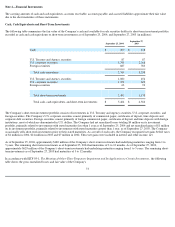Apple 2004 Annual Report Download - page 69
Download and view the complete annual report
Please find page 69 of the 2004 Apple annual report below. You can navigate through the pages in the report by either clicking on the pages listed below, or by using the keyword search tool below to find specific information within the annual report.
approximately $6 million representing the increase in fair value of the agreement from June 29, 2003 through the settlement date.
Derivative Financial Instruments
The Company accounts for its derivative instruments as either assets or liabilities and carries them at fair value. Derivatives that are not hedges
must be adjusted to fair value through income. If the derivative is a hedge, depending on the nature of the hedge, changes in fair value will either
be offset against the change in fair value of the hedged assets, liabilities, or firm commitments through earnings, or recognized in other
comprehensive income until the hedged item is recognized in earnings.
For derivative instruments that hedge the exposure to variability in expected future cash flows that are designated as cash flow hedges, the net
gain or loss on the derivative instrument is reported as a component of other comprehensive income in shareholders' equity and reclassified into
earnings in the same period or periods during which the hedged transaction affects earnings. To receive hedge accounting treatment, cash flow
hedges must be highly effective in achieving offsetting changes to expected future cash flows on hedged transactions. For derivative instruments
that hedge the exposure to changes in the fair value of an asset or a liability and that are designated as fair value hedges, the net gain or loss on
the derivative instrument as well as the offsetting gain or loss on the hedged item attributable to the hedged risk are recognized in earnings in the
current period. The net gain or loss on the effective portion of a derivative instrument that is designated as an economic hedge of the foreign
currency translation exposure of the net investment in a foreign operation is reported in the same manner as a foreign currency translation
adjustment. For forward contracts designated as net investment hedges, the Company excludes changes in fair value relating to changes in the
forward carry component from its definition of effectiveness. Accordingly, any gains or losses related to this component are recognized in
current earnings. For derivative instruments not designated as hedging instruments, changes in fair value are recognized in earnings in the
current period.
In accordance with SFAS No. 133, hedges related to probable but not firmly committed transactions of an anticipatory nature are designated and
documented at hedge inception as cash flow hedges and evaluated for hedge effectiveness quarterly. For foreign currency forward contracts
designated as cash flow hedges, hedge effectiveness is measured based on changes in the fair value of the contract attributable to changes in the
forward exchange rate. Changes in the expected future cash flows on the forecasted hedged transaction and changes in the fair value of the
forward hedge are both measured from the contract rate to the forward exchange rate associated with the forward contract's maturity date. For
currency option contracts, hedge effectiveness is assessed by comparing the present value of the cumulative change in expected future cash flows
on the hedged transaction to changes in expected cash flow of the option hedge at maturity. The net gains or losses on derivative instruments
qualifying as cash flow hedges are reported as components of other comprehensive income in shareholders' equity and reclassified into earnings
in the same period or periods during which the hedged transaction affects earnings. Any hedge ineffectiveness is recognized in current earnings
in other income and expense. For interest rate swap agreements qualifying as fair value hedges, the Company assumes no ineffectiveness
because these swaps meet the criteria for accounting under the short-cut method.
The Company may enter into foreign currency forward contracts to hedge the translation and economic exposure of a net investment position in
a foreign subsidiary. For such contracts, hedge effectiveness is measured based on changes in the fair value of the contract attributable to
changes in the spot exchange rate. The effective portion of the net gain or loss on a derivative instrument designated as a hedge of the net
investment position in a foreign subsidiary is reported in the same manner as a foreign currency
65
























